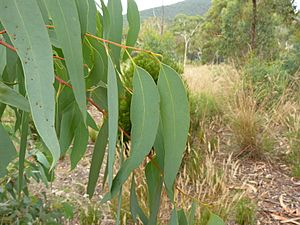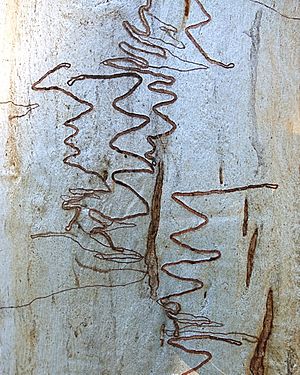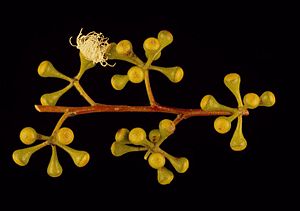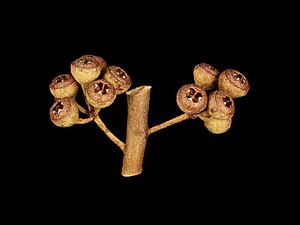Inland scribbly gum facts for kids
Quick facts for kids Inland scribbly gum |
|
|---|---|
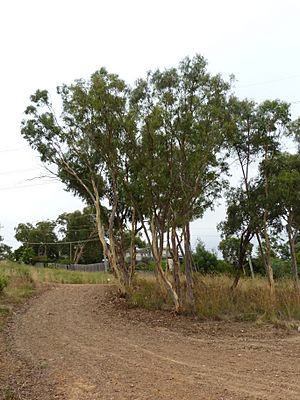 |
|
| Eucalyptus rossii in the Aranda Bushland | |
| Scientific classification | |
| Genus: |
Eucalyptus
|
| Species: |
rossii
|
| Synonyms | |
|
Eucalyptus racemosa subsp. rossii (R.T.Baker & H.G.Sm.) B.E.Pfeil & Henwood |
|
The Inland Scribbly Gum (scientific name: Eucalyptus rossii) is a special type of tree found only in New South Wales and the Australian Capital Territory in Australia. It's known for its smooth bark that often has cool "scribble" marks made by tiny insects. This tree usually grows to be a small to medium size. It has long, narrow leaves, white flowers, and small, round fruits.
Contents
What the Inland Scribbly Gum Looks Like
The Inland Scribbly Gum is a tree that typically grows to be about 15 to 20 meters tall. That's like a five-story building! It usually has one straight trunk and a crown of leaves that spreads out about 9 meters wide.
Bark and Leaves
The bark of this tree is smooth and yellowish. It peels off in patches all year round. You'll often see unique "scribbles" on the bark. These marks are made by tiny insects burrowing just under the surface.
Young trees and new shoots have long, narrow leaves, about 7 to 14 centimeters long. Adult leaves are arranged in a different way. They are the same green color on both sides and are also long and narrow, usually 5.5 to 15 centimeters long.
Flowers and Fruit
The flowers of the Inland Scribbly Gum are white. They grow in groups of five to fifteen buds. These buds are oval-shaped and small, about 3 to 5 millimeters long. The tree blooms between September and February, which is during spring and summer in Australia.
After the flowers, the tree produces small, woody fruits. These fruits are shaped like a cup or a hemisphere, about 3 to 6 millimeters long.
Where Inland Scribbly Gums Grow
You can find the Inland Scribbly Gum scattered across the tablelands, western slopes, and central coast of New South Wales, all the way from Tenterfield in the north to Bombala in the south.
Preferred Habitat
These trees like to grow in sandy and stony soils that drain water well. They are often found on slopes. They thrive in areas with moderate temperatures and rainfall, usually receiving 600 to 1000 millimeters of rain each year. They are part of open dry woodland areas.
The Mystery of the Scribbles: Ecology
The most interesting feature of these trees is the "scribble" marks on their bark. These marks are actually tunnels made by the larvae (baby insects) of a small moth called Ogmograptis scribula.
The moth lays its eggs inside the layers of the tree's bark. When the larvae hatch, they start to burrow, creating these winding patterns as they eat their way through the bark. It's like a natural art project on the tree trunk!
Growing Inland Scribbly Gums
You can buy Inland Scribbly Gum seeds or young plants from nurseries. They make great shade trees because they grow well in full sun and can handle poor, shallow, or stony soils.
These trees are also tough! They can survive both drought (very dry periods) and frost (freezing temperatures). Their white flowers attract birds, making them a nice addition to a garden.


